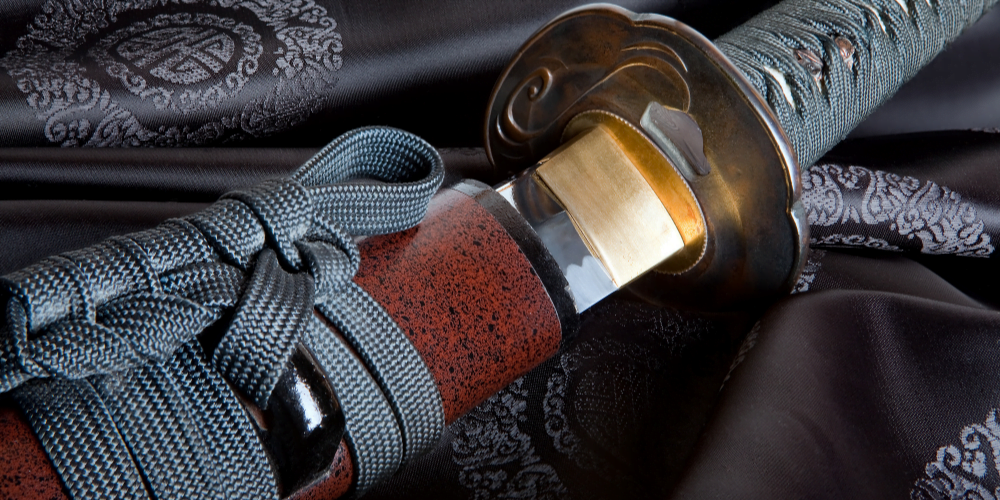Knight & Samurai
by Ed and The OM Team | Good Reads, Print Articles, Summer 2021
The duality of the archetype of the initiated or fully-developed man.
In this day and age of technology and ideology, it is essential that you create something with your hands. To do so is to experience how the world works at its most fundamental level. We have to put away our theories and learn from the very things that ideologues have typically wanted to control or remake to fit their ideology: the body. For, contrary to the view of many intellectuals, the body is not something that can be neglected in favour of the intellect. Nor, contrary to the view of many spiritual teachers, is the body a kind of used car, meant merely to drive our soul around from A to B. The body matters. It is through the body that we experience the world and, as such, come to have a sense of the miraculous or the mystery of life and the feeling that there must be something beyond it.
It is common for new theories to arise, claiming, for example, that we should eat certain foods which have been modified for optimal health. Generally, after some time, we discover something was wrong with the theory and it turns out that the whole fruit, whole egg, and so on, is better for us than those that have been modified or that have had parts removed or added. Instead of theorising, we can try to model our diet on that of our ancestors, eating natural whole foods, seeing what works for us, and cutting out what causes our body any kind of problem.
Just as food affects the way we feel, physically, so ideas affect our mental stability, emotional well-being, and our spirit or our attitude. And just as we can see how we feel after eating certain food, so we can watch our thoughts to see how an idea, or a belief system, affects our emotions and our attitude towards others and towards life. And we must reject those ideas and belief systems that damage us. If an idea or an ideology leads us to feel depressed, angry, resentful, or to blame others or to feel incapable of acting on our own behalf, then we should reject it. If, however, an idea or a belief makes us feel enthusiastic, positive, loving, patient, optimistic, determined, and capable, then it is more likely to express something of our true or archetypal nature.
Practising some kind of physical art or discipline can help us in regard to understanding our thinking, especially our preconceptions. I want to paint a self-portrait, let’s say. I do not realise it, but, due to some insecurity, I have a conception of my face that is incorrect. I think I have a long nose, or big ears, small eyes, or small lips. I begin drawing my face, but, then, as I look in the mirror and check the proportions, I discover that my face is not as I had thought. I have drawn my nose too long or the ears too big, because of my distorted self-image. I must correct the drawing and I must correct my own self-image.
Or I think I know how to look after a plant, but place it where it will not get enough light. Then it withers, and I am forced to move it to where it will get sunlight. Or perhaps I think I know how to cook some particular food, but I over-spice it or undercook it. Or I might believe I have mastered a martial art, but then I get punched in the face by someone with less training. In any case, I have to have the humility to think about what I did wrong, and adjust. My beliefs have to be less important than the physical nature that I am working with.
To work with the hands—aspect of the Creator of the world itself. It requires us to know how things work, to accept the quality of each thing, and, to be able to work with them, rather than trying to impose our wrong ideas on reality.
Once I accept its qualities, I can focus on, and develop, the object of my attention, sometimes finding interesting new applications or possibilities. Hence, accepting that gold is too soft and too scarce to be used in the production of tools, but noting that it reflected the light of the fire, it was used ritualistically and decoratively, covering the monarch’s throne, for example. Noticing that the arms and other parts of the body had limitations in where and how they could move, some martial arts developed methods for subduing an opponent by manipulating them in ways that were unnatural, and thus painful or that prevented an opponent from moving to counter-attack.
But that is only one way in which we work with the object of our attention. The other involves our own body, which harmonises with it. The martial artist must use his own body when grappling with an opponent. When painting, using the traditional tools of ink and brush, the Chinese or Japanese artist will exhale as he makes each stroke. Polishing a mirror or cleaning and polishing a sword involved the use of the breath in the same way, and so was considered a type of meditation. But we find this elsewhere. When a tailor cuts fabric, he will look in front of the shears and exhale as he slides the shears through the cloth. How the body is used is dictated by the object itself. It is the same principle.
But the body, too, must be cultivated. Plato believed physical training (gymnastic) should be taught from early childhood and that it should continue to be practised throughout the life of the individual. However, this, he believed, had to be learned and practised alongside music, because “exclusive devotion to gymnastic” tends to produce “a temper of hardness and ferocity,” while single-minded devotion to music produces an equally undesirable “softness and effeminacy.”
In the west, we have come to associate the spiritual man with the figure of Jesus, at least as he has overwhelmingly been represented in Christian art: placid, passive, slender, soft, and meek. And even as Christianity has declined in many parts of the west, this image lives on in our psyches. As such, perhaps it seems that we are overemphasising the physical. After all, both religion and spirituality ultimately direct our attention away from the material world and toward the Divine. But without a grounding in a physical practice, where we must face our limitations and overcome them—only to face new limitations and overcome those—it is easy to detach ourselves from reality and to fool ourselves that our quirks, fantasies, and delusions are proof of our spiritual superiority and perhaps even of psychic ability. We must wrestle with reality, as Sri Aurobindo, has said, discovering infinity out of our limitations.
Doubtlessly, the thin, mysterious, effeminate man in contact with spirits and immersed in dreams is one male archetype. There is something both religious and sexual—and even sexually ambiguous—about him. He is the artist, the mystic, dreamer, poet, author, and sexual adventurer. He emerges in the figure of the tribal shaman, who sometimes dressed in female clothes, thus presenting himself as both male and female. At once transgressing and embodying nature, it was this contradiction that gave the shaman his power to speak directly with nature and its manifestations as spirits or demons. In Norse mythology, too, we hear Odin—the god of war, magic, and poetry—being criticised for being “unmanly.” The basis of this accusation is Odin’s practice of a feminine type of magic (Seið), but, a more British or European than American sensibility, in the modern era we find this archetype emerging through such figures as David Bowie (especially, perhaps, in his Ziggy Stardust persona), the band Bauhaus, and in the art of Aubrey Beardsley.
Nevertheless, this figure—like that of its opposite, the vulgar, unthinking man who trains his body but not his mind—is merely a shadowy half of what we are aspiring to be. We have not only mentioned Plato’s belief that the individual should be educated and practised in both the hard and soft arts, but we have also looked at these dual qualities in the knight, in chivalry, and in the samurai, and it is this dual nature, and its cultivation, that provides us with a more complete and multidimensional model or archetype of the initiated or fully-developed man.”
Excerpt from Chapter 3: The Necessary Work
From the book: The Path of the Warrior-Mystic.
Being a Man in an Age of Chaos
About the Author: Angel Millar is a well-known lecturer on initiation, symbolism, Freemasonry, and self-development as well as an artist and student of the martial arts. The author of several books, including The Three Stages of Initiatic Spirituality and The Path of the Warrior-Mystic, he lives in New York City. https://angelmillar.com/
The Path of the Warrior-Mystic by Angel Millar © 2021 Inner Traditions. Printed with permission from the publisher Inner Traditions International. www.InnerTraditions.com



One Response
Excellent content. Very valuable.